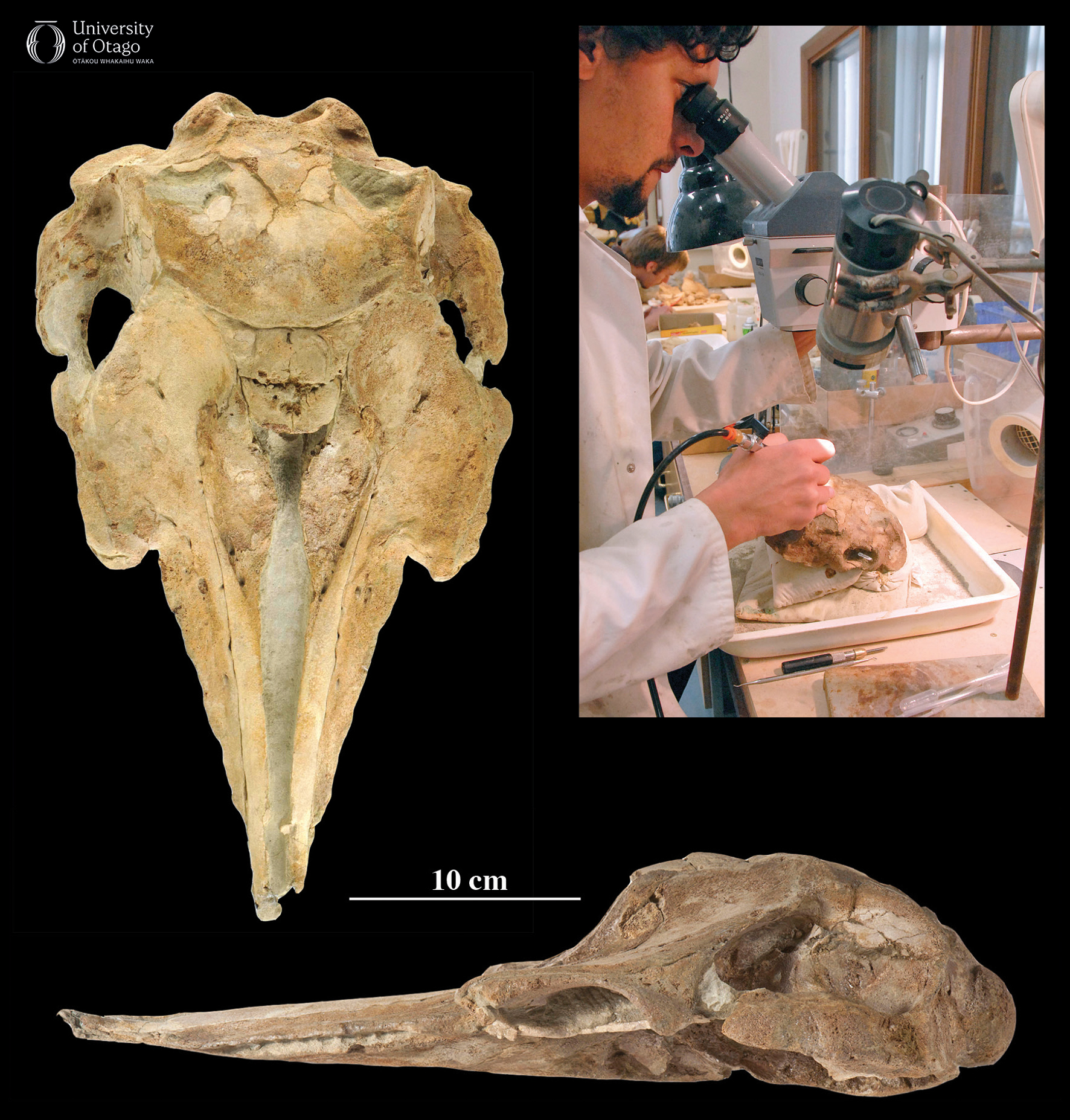24 Young hunter from dark age of whale evolution
Cetacea, Odontoceti: Papahu taitapu
Whales and dolphins are collectively known as cetaceans and arose from an ancestor that was a close relative of the hippopotamus. This cetacean ancestor lived around 50 million years ago during the Paleocene along an ancient coastline of what is now the Indian subcontinent. Cetaceans then began to spread around the world and diversify, and by the end of the Oligocene the two major groups that we recognise today had emerged, baleen whales (mysticetes) and toothed whales (odontocetes, which includes dolphins and porpoises).

Skull from the ancient dolphin Papahu taitapu (specimen OU 22066). Visible lines between bones in the skull (i.e. sutures) show that the skull is from an adolescent. The top right image shows Gabriel Aguirre-Fernández preparing the fossil as part of his doctoral thesis research. Image credit: RE Fordyce. |
Crucially though, the cetaceans that lived in these 23 million year old late Oligocene oceans were mostly archaic species that were distantly related to modern species. What follows next in cetacean evolutionary history is something of a mystery, as cetacean fossils are rare in rocks aged between 23 and 20 million years old. This span of time has been described as a global “dark age” in whale evolution. In the times immediately following this “dark age” the oceans became filled with a diversity of whale and dolphin species that appear much more like their living relatives. So how and why did cetacean diversity change so much during this time? One of the ways the fossil record of Aotearoa is important for whale evolution is that it includes cetacean fossils from this “dark age” and can therefore help to answer these questions. The odontocete Papahu taitapu from the northern South Island is one such fossil, dated between 21.7 and 18.7 million years old.
Papahu taitapu is a close relative of modern dolphins but doesn’t itself have living descendants. Like living dolphins, Papahu taitapu used high frequency sound to navigate and find prey, and had rows of small, conical teeth for seizing this prey.
Only a single specimen of Papahu taitapu has been discovered so far. This specimen was collected by Ewan Fordyce and Andrew Grebneff from North West Nelson in 1987. These paleontologists found the fossil exposed on a rock platform at high-tide level. Upon collection and preparation, the fossil was revealed to be a skull that was missing part of the snout (i.e. part of the rostrum). Other bones that were found alongside the skull included an ear bone, a lower jaw, some vertebrae, and a rib.
Ewan Fordyce and PhD student Gabriel Aguirre-Fernández determined that Papahu taitapu was around 1.8 m long but was probably still a young individual. At 1.8 m long, Papahu taitapu would have been similar in size to some of the smaller living dolphins like the common dolphin, Delphinus delphis. When studying the shape of the skull the researchers observed that the blowhole was placed between where it would have been on an archaic odontocete (towards the front-end of the skull) and where it is placed on a modern dolphin (on the top of the head). This intermediate placement is exactly what would be expected from a “dark age” fossil, as it lived in the time following the most archaic cetaceans but before modern species evolved.
—Written by Daniel B Thomas
| Specimen number: OU 22066 | Age: Approximately 22.5 million years old (latest Oligocene, Waitakian stage) |
| Locality: North West Nelson | Rock Formation: Kaipuke Formation |
| Collected by: RE Fordyce, A Grebneff | |
| Citation: Aguirre-Fernández G, Fordyce RE. 2014. Papahu taitapu, gen. et sp. nov., an early Miocene stem odontocete (Cetacea) from New Zealand. Journal of Vertebrate Paleontology 34:195–210. doi:10.1080/02724634.2013.799069 | |
A group of marine mammals with around 90 living species across two key clades, Mysticeti (baleen whales) and Odontoceti (toothed whales, including dolphins and porpoises). The fossils of many extinct species of cetacean have been discovered.
66 to 56 million years ago.
An ancient precursor to the modern Indian Ocean, the Mediterranean Sea, and the Black Sea and Caspian Sea.
33.9 to 23.03 million years ago.
Cartilage plates suspended from the upper jaw in the mouth of mysticete whales. Used to strain prey from sea water.
Marine mammals within Cetacea that have large keratin plates (baleen) for filtering food from water. One of two major clades within Neoceti, with the other being Odontoceti. Living examples include blue whale (Balaenoptera musculus) and southern right whale (Eubalaena australis).
Marine mammals within Cetacea that have teeth. One of two major clades within Neoceti, with the other being Mysticeti. Living examples include sperm whale (Physeter macrocephalus) and Hector's dolphin (Cephalorhynchus hectori).
Approximately 27 to 23.03 million years ago. The late Oligocene is not a formally defined segment of geological time, but instead refers to the final three or four million years of the Oligocene Epoch.
Ancient close relatives of living whale and dolphin species. In taxonomic terms, 'archaeocetes' are all species within Cetacea that are not within Neoceti.
Evidence of life from a past geological age. Remains like bones, shells or wood, or an impression like a footprint, or some other evidence of life, from something that was alive more than 11,700 years ago.
The region of a skull that holds the teeth, palate, and nasal cavity. Can be elongated into beak or bill.
The series of bones forming the flexible 'backbone' structure of the animals named for possessing these bones, the vertebrates.
Where the nostrils open on the top of the head, enabling the animal to breathe.

